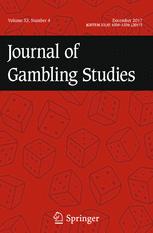 Título: The Effects of Modeling and Experience on Young Children’s Persistence at a Gambling Game
Título: The Effects of Modeling and Experience on Young Children’s Persistence at a Gambling Game
Autores: George C. Tremblay, Loreen Huffman, Ronald S. Drabman
Data: 1998
Abstract
Gambling is common among children and adolescents, but Hide is known about factors initiating or maintaining this behavior. Fifty-one male and 51 female kindergarten and first grade children were invited to play a game involving repeated opportunities to select colored chips from a cup while blindfolded. Children playing for tangible incentives elected to play longer than those who were not (p< .001). Seeing a videotaped model win or fail to win a large prize had no effect on persistence with the game. Playing again one week later, children playing for incentives exhibited a more successful strategy, quitting sooner (p < .04) and with more winnings (p < .03). The parameters of experiential versus observational learning are discussed, with implications for educating children about risk-taking.
REFERENCES
-
Arcuri, A. F., Lester, D., & Smith, F. O. (1985). Shaping adolescent gambling behavior. Adolescence, 20, 935–938.Google Scholar
-
Bandura, A. (1986). Social foundations of thought and action: A social cognitive theory. Englewood Cliffs, NJ: Prentice Hall.Google Scholar
-
Custer, R. L. (1982). An overview of compulsive gambling. In P. A. Carone, S. F. Yoles, S. N. Kiefer, & L. Krinsky (Eds.) Addictive Disorders Update: Alcoholism, drug abuse, gambling (pp. 107–124). New York: Human Sciences Press.Google Scholar
-
Dell, L. J., Ruzicka, M. F. & Palisi, A. T. (1981). Personality and other factors associated with the gambling addiction. International Journal of the Addictions, 16, 149–156.Google Scholar
-
Derevensky, J. L., Gupta, R., Della Cioppa, G. (1996). A developmental perspective of gambling behavior in children and adolescents. Journal of Gambling Studies, 12, 49–66.Google Scholar
-
Fisher, S. (1992). Measuring pathological gambling in children: The case of fruit machines in the U.K. Journal of Gambling Studies, 8, 263–285.Google Scholar
-
Fisher, S. (1993). Gambling and pathological gambling in adolescents. Journal of Gambling Studies, 9, 277–288.Google Scholar
-
Fisher, S. (1995). Adolescent slot machine dependancy and delinquency: Questions on a question of methodology. Journal of Gambling Studies, 11, 303–310.Google Scholar
-
Fisher, S., & Griffiths, M. (1995). Current trends in slot machine gambling: Research and policy issues. Journal of Gambling Studies, 11, 239–247.Google Scholar
-
Griffiths, M. (1990). The acquisition, development, and maintenance of fruit machine gambling in adolescents. Journal of Gambling Studies, 6, 193–204.Google Scholar
-
Griffiths, M. (1993). Factors in problem adolescent fruit machine gambling: Results of a small postal study. Journal of Gambling Studies, 9, 31–45.Google Scholar
-
Griffiths, M. (1994). The role of cognitive bias and skill in fruit machine gambling. British Journal of Psychology, 85, 351–369.Google Scholar
-
Griffiths, M. (1995). Towards a risk factor model of fruit machine addiction: A brief note. Journal of Gambling Studies, 11, 343–346.Google Scholar
-
Gupta, R. & Derevensky, J. (1997). Familial and social influences on juvenile gambling behavior. Journal of Gambling Studies, 13, 179–192.Google Scholar
-
Inhelder, B. & Piaget, J. (1958). The growth of logical thinking from childhood to adolescence. (A. Parsons & S. Milgram, Trans.). New York: Basic Books.Google Scholar
-
Jacobs, D. F. (1989a). A general theory of addictions: Rationale for and evidence supporting a new approach for understanding and treating addictive behaviors. In H. J. Shaffer, S. A. Stein, B. Gambino, & T. N. Cummings (Eds.), Compulsive Gambling: Theory, Research and Practice (pp. 35–64). Toronto: Lexington Books.Google Scholar
-
Jacobs, D. F. (1989b). Illegal and undocumented: A review of teenage gambling and the plight of children of problem gamblers in America. In H. J. Shaffer, S. A. Stein, B. Gambino, & T. N. Cummings (Eds.), Compulsive Gambling: Theory, Research and Practice (pp. 249–292). Toronto: Lexington Books.Google Scholar
-
Kearney, C. A. & Drabman, R. S. (1992). Risk-taking/gambling-like behavior in preschool children. Journal of Gambling Studies, 8, 287–297.Google Scholar
-
Ladouceur, R., & Dube, D. (1994). Gambling among primary school students in the Quebec Metropolitan area. Journal of Gambling Studies, 10, 363–370.Google Scholar
-
Ladouceur, R., Dube, D., & Bujold, A. (1994a). Gambling among primary school students. Journal of Gambling Studies, 10, 363–370.Google Scholar
-
Ladouceur, R., Dube, D., & Bujold, A. (1994b). Prevalence of pathological gambling and related problems among college students in the Quebec metropolitan area. Canadian Journal of Psychiatry, 39, 289–293.Google Scholar
-
Ladouceur, R. & Mireault, C. (1988). Gambling behaviors among high school students in the Quebec area. Journal of Gambling Behavior, 4, 3–12.Google Scholar
-
Lesieur, H. R., & Klein, R. (1987). Pathological gambling among high school students. Addictive Behaviors, 16, 517–527.Google Scholar
-
Liebert, R. M. (1986). Effects of television on children and adolescents. Journal of Developmental and Behavioral Pediatrics, 7, 43–48.Google Scholar
-
Moody, G. (1989). Parents of young gamblers. Journal of Gambling Behavior, 5, 313–320.Google Scholar
-
Shaffer, H. J., & Hall, M. N. (1996). Estimating the prevalence of adolescent gambling disorders: A quantitative synthesis and guide toward standard gambling nomenclature. Journal of Gambling Studies, 12, 193–214.Google Scholar
-
Stein, S. (1989). A developmental approach to understanding compulsive gambling behavior. In H. J. Shaffer, S. A. Stein, B. Gambino, & T. N. Cummings (Eds.), Compulsive Gambling: Theory, Research and Practice (pp. 65–88). Toronto: Lexington Books.Google Scholar
-
Yeoman, T., & Griffiths, M. (1996). Adolescent machine gambling and crime. Journal of Adolescence, 19, 183–188.Google Scholar
Fonte: Springer















